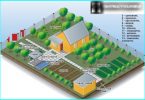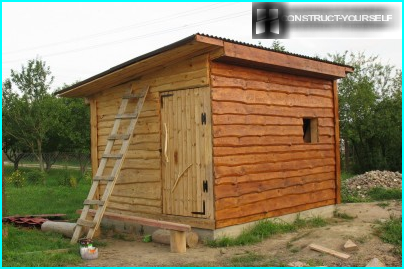
It just so happened that we are all trying to create a small «world», fencing private land from the manifestations of the outside world — neighbors and curious passers-by, the wind and the noise, exhaust fumes and roar of the cars. However, not all of us happy with the prospect of constantly abut glance a little poor six-foot fence, delineating the boundaries of our domain. How to make your «Kingdom» inaccessible to outsiders without disturbing the natural beauty of the garden landscape? The answer to this question lies in the depths of the 18th century, when it was first grown hedge is a dense linear planting of garden plants, designed to protect and at the same time, decorate private area.
The contents
Familiarity with green fence
Green fence, located on the border of your land, will become a natural barrier to dust, noise and wind and annoying neighbours and uninvited guests. A particularly good hedge in the country, as it does not require such a significant financial investment, as the construction of a permanent fence. A great option for a suburban area – free-growing hedge with their hands to create it quite easy as it does not require periodic haircuts, like a regular hedge of regular geometric shape. Special attention deserves the hedge of roses that will decorate the facade of the house, gazebo or dull fence. Looks impressive hedge of maiden grapes — it does not need special care, and red autumn grape leaves in the garden will create a festive atmosphere.
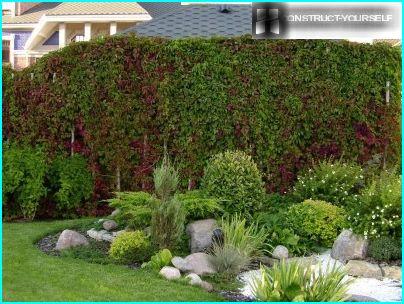
Hedge of grapes can serve as a fence, and a good background for other elements of landscape design
Types of green hedges
Hedges have gone a long way before you find yourself in our time. Perhaps that is why, a fence formed with the help of ornamental plants have such a variety of types and forms.
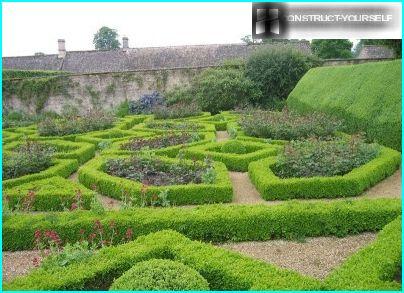
Hedges, shaped in the form of a low curb — the original setting for flower beds and walkways
On the basis of such characteristics of the hedge as the height, it is possible to allocate three types of the enclosing plantings:
- low curbs of up to 1 meter in height — for outlining the borders of lawns, flower beds, walkways
- hedge height of 1-2 meters is to divide the area into functional zones
- living wall height of 2 metres or more, for planting along the boundaries of the site
Depending on the intensity of cutting, the green fence is divided into moulded and freely growing. Unlike molded hedges, which by means of a clipper is attached to a clear geometric shape, freely growing fence practically not subjected to correction and grow in any direction.
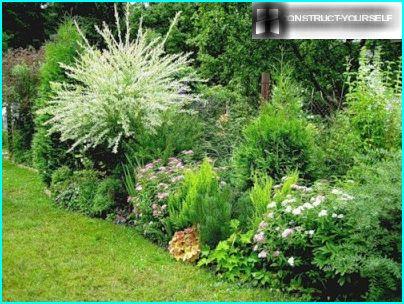
Free growing hedge of different kinds of shrubs will dot the landscape plot in landscape style
Another parameter that klassificeret hedges — the rows of planting. Green hedge, where plants are planted in one line refers to a single row. Two and three-row hedges involve the placement of plants in several lines in the form of uneven tiers. Single-row hedges formed of plants planted at an equal distance from each other. For shrubs adhere to the step landing approx 30-50 cm, for trees ranging from 75 to 150, see multi-row hedge plants are planted in a checkerboard pattern, the distance between them is observed depending on the expected size of the crown and height.
Multi-row cascading hedges create a certain degree of imagination, combining freely growing and formed «stage» of various types of shrubs and trees. Beautiful flowering fence you can create with shaped hedges of honeysuckle, Saskatoon, barberry and other bushes. For planting hedges of mixed type use plants of the same species, but different varieties with different colored foliage or pine needles. Look good combination of purple and green beech, green, and variegated Privet or Holly. Such multi-layered fences take a lot of place, but more effective protect from prying eyes or intrusion, polluted atmosphere and the noise of the motorway.
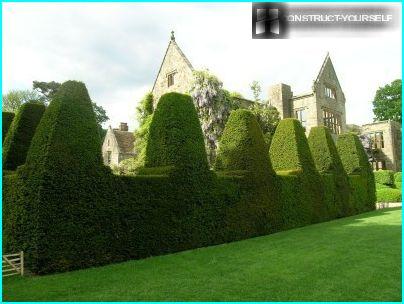
To create a molded hedges are best planted plants with small leaves — they provide fence, dense surface
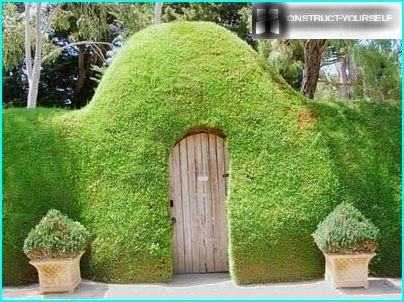
In the process of cutting, green fence might be any shape, from geometric to rounded
Selection of plants for green hedges
When selecting plants for planting in hedges, it is better to give preference to those who have passed «test of strength» in domestic climatic conditions. It should be hardy, undemanding plants with dense foliage, which are well restored after the haircut and have a high ability to form shoots. You should pay attention to such trees as maple, hornbeam, blackthorn and shrubs — Privet, hawthorn, cotoneaster. Look spectacular hedges of Jasmine, sea buckthorn, rhododendron, barberry, honeysuckle, roses wrinkled, lilac, Saskatoon. To create a green hedge select plants with small leaves, which when periodically cut to form a uniform surface.
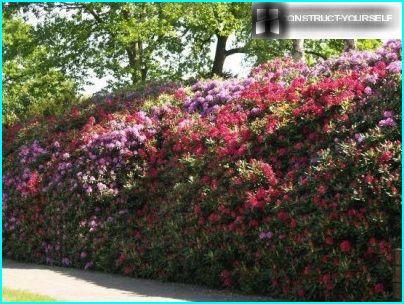
Dense impenetrable hedge can be created from lilac bushes and rhododendron growing free way
Planting green fence
When selecting planting materials for hedges, it is necessary to look at the root system and the crown of the plant — roots should not be dry, crown — uniform in shape. For planting vegetable planting in hedges choose young shrubs and trees aged 3 to 6 years, which are quite developed and can easily fit in a new environment.
Before the formation of the green fence you need to learn how to plant a hedge, the plants had plenty of sun, moisture and nutrients. In this context, the important point is the selection of place for planting hedges and a season for migration of plants in the open ground. As a rule, the laying of hedges is done in the spring after the soil has already dried out, or autumn, if for forming living fences selected hardy plants. The location of the green fence is chosen away from buildings at a minimum distance of 2 meters and 0.5-1.5 m from capital fence.
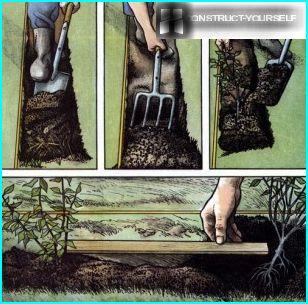
When planting a hedge you need to dig a trench to aerate and fertilize her bottom, place the seedling and compact the ground
Before planting a hedge it is necessary to identify the line location with the aid of the stretched cord. Along the lines of digging a trench with a depth of about 0.5 meters. The trench width depends on the tiering of the green hedge — row, for it is 40-50 cm, for multilane — 50 cm for each subsequent row. The density of planting of a hedge is influenced by the characteristics of specific plants, the proposed height and number of rows of living fences.
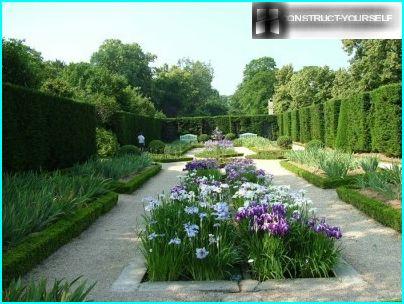
Dense hedges are used to create the garden of secluded places to relax — «green room»
The density of planting 1 meter of the fence:
- low shrub (mahonia, Spiraea) bushes 5-7;
- medium shrubs (snowberry, cotoneaster) 4-5 bushes;
- high (2-3 m) trees and shrubs (physocarpus, hawthorn) 1-2 plants.
Planting a hedge of conifers
When planting conifer trees, dig the hole diameter is 2 times the size of the rhizome. The garden soil you removed when digging a hole, mix the compost, organic fertilizer and silica, after which it sprinkle the bottom of the pit. Coniferous plants most often sold in plastic containers. Before planting the plant is carefully removed from the container and planted in the open ground with a clod of earth intact. After the tree is set in the planting hole, it is covered with earth, which is then compacted, but not RAM. At some distance from the line planting irrigation form a crest in the form of a low mound that prevents the spreading of water. After planting, the plants watered abundantly.
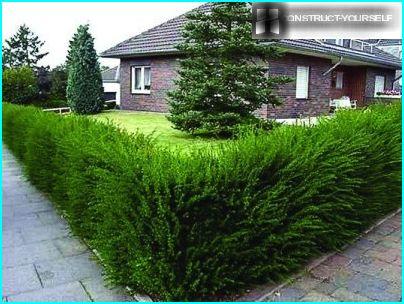
Hedge, delighting the eye with its verdure all the year round, may be formed of evergreen conifers
Planting hedges of deciduous plants
Deciduous medium-tall or tall shrubs and trees are sold, primarily, with an exposed root system that is washed before planting for several hours and cut, removing the damaged and long spines. A hole ready for planting, and to plant the plants at a depth not exceeding that for which it was planted previously. The earth excavated from the pit, mixed with organic fertilizers, compost and partially recycled to the bottom of the pit. A Bush or tree is placed in the pit and sprinkle the remaining ground, tracking the density of the backfill to between the roots of the plants have not formed the voids. If the tree has high stem, the bottom of the pit, a depth of about 50 cm, hammer support number, which at the end of the planting, loosely tie the tree.
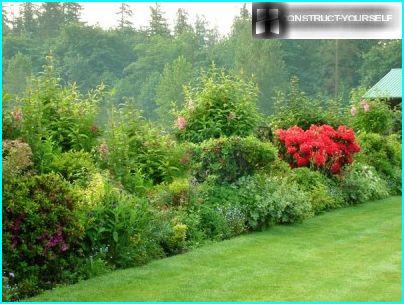
Free-growing hedges often formed of various deciduous trees and shrubs
Planting a hedge of bushes
Seedlings low shrub, usually grown in plastic containers, which provide the root system of plants protection. This allows a precise timing of the landing of bushes in the open ground. The hole for planting Bush is prepared taking into account the size of the plants roots and earthen coma. When planting a plant is released from the container with the preservation of earthen coma and placed in a dug hole. After void filling the planting hole with earth, the top layer of the soil is a bit compacted and watered.
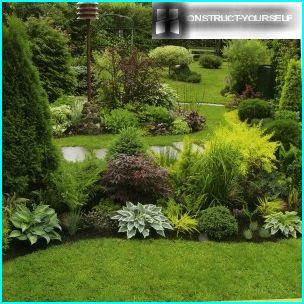
The hedges in the form of free-growing border of dwarf shrub gently outline the border of a green lawn or lawn
For planting of large shrubs need to dig a trench width of about 1 m and a depth of 50-60 cm the bottom of the trench loosened with a pitchfork to a depth of 20cm and mix the loosened soil with peat, leaf humus, manure or compost. Good idea to add lime, wood ash and a little phosphate fertilizer.
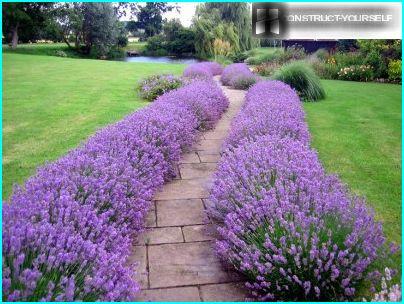
Lavender bushes, planted in a rounded border, effectively accentuate the path leading to the house
Planting hedge fences
Quite often, when forming a hedge in the country, saving space small garden plot is in the forefront. How to grow a hedge in the cramped conditions of allotment, limited to 6 acres? In order to create a green hedge in the form of thick, but not wide trellis, the plants are thrown at a small distance from each other — about 20 cm trellis fence looks great, if it is formed from plants such as yellow acacia, willow, Rowan or hawthorn.
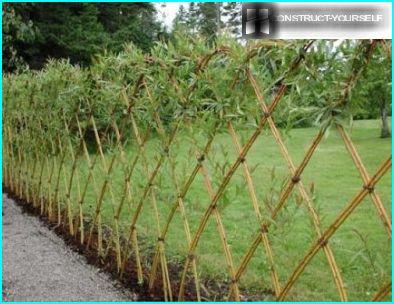
Thin and, at the same time, dense hedge-trellis can be formed from an ordinary willow
A year planted trees and shrubs pruned, as they say, «on the stump» — leaving 10-15 cm of the aerial parts of the plant. A year later, in the spring, conduct a thorough pruning of the hedge, keeping a few of the strongest shoots that intertwine criss-cross under an angle of 45 degrees, cutting the bark at points of contact of the branches. Received diamond «pattern» secured to the frame in the form of a lattice structure constructed on the basis of stakes driven in small increments into the ground, and cross members.
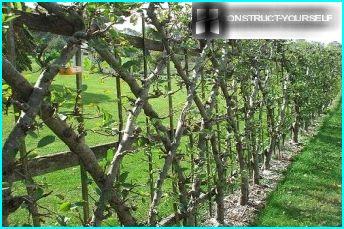
Hedge a hedge is grown by the method of cross weave shoots of shrubs or stunted trees
Subsequently, all the side shoots of the trellis are cut 2-3 times per season, adhering to the vertical plane, to encourage further branching of the fence up. Regular haircut side hedge of the hedge is aimed at creating a uniform width of about 30 cm Trellis also cut the top, maintaining a certain height of the green fence.
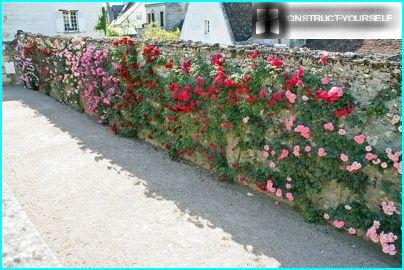
Monotonous gray of the fence can spice things up with bright richly «blooming trellis» twine of roses
Care of green hedges
Putting on an individual or village green fence, be aware that the departure during the season for the hedge is much more difficult than for ordinary garden plants. This is due in large measure to the fact that for vegetable hedges need to relentlessly follow is to water, fertilize and mow. If you treat the issue of pruning and shearing hedges without proper attention — she could grow that to put it in order would be impossible and will have to trim the fit «to zero».
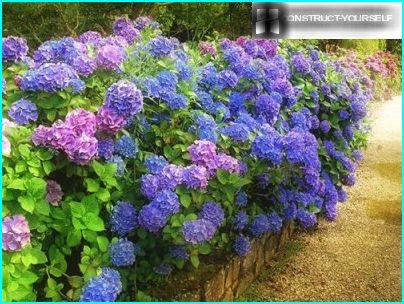
The lush inflorescences hydrangeas, gathered in the hedge, decorate your garden a Prime focus and will protect against intruders
The rules of cutting and trimming
Pruning at planting
Deciduous varieties of trees and bushes formed a hedge, heavily pruned immediately after planting, leaving 10-15 cm of the aerial parts of the seedlings, to accelerate the growth of shoots at the base. If the seedlings were purchased with bare root system, pruning of the aerial part should be done in half the existing height. Seedlings grown in a container, cut off one-third of the height.
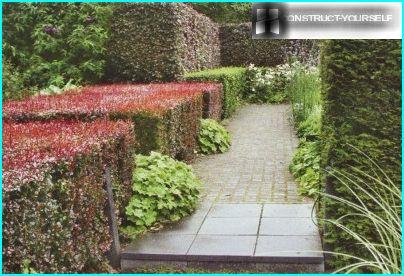
The combination of the uneven borders and multicolored geometric shapes will give your garden a unique flavor
Pruning in the second season
A year later, planted hedges trimmed about 4 times a season — from may to August. Light pruning in the second year of the existence of the fence aimed at giving the fit a specific shape and increased density of branching.
Hard pruning — to a height of about 15 cm from the ground surface in need of these types of shrubs: Privet, hawthorn, sloe, tamarisk. At 1/3 of the height of new shoots cut: cotoneaster, hornbeam, barberry, boxwood, beech. Drastic pruning is not required: juniper, Laurel, kiparisny, cypress. Such hedges are cut only certain twigs, which stand out of the crowd and give the hedges look untidy.
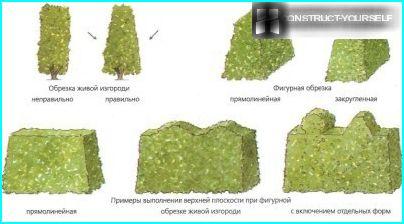
Trimming hedges is such a way that its lower part was wider. than the top
Haircut in 2-3 years
Shearing hedges in subsequent years are to make a decorative fence, a neat appearance — side branching cut the top shoots a little trim. Deciduous trees and shrubs trimmed in the early spring — even before the appearance of young leaves, coniferous evergreens can be trimmed later spring or early autumn.
It is important to know! When cutting green fence basis shape is slightly wider than the top so lower branches sufficiently covered and, accordingly, developed.
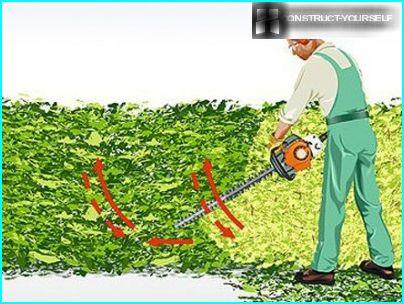
For cutting a long molded hedges using special tool

The upper trimming hedges perform at a height of about 10 cm, pre-pulling bichescu for reference
A hedge of evergreen or small-leaved plants, shorn of the electric tool or scissors. For cutting and trimming large hedges use secateurs.
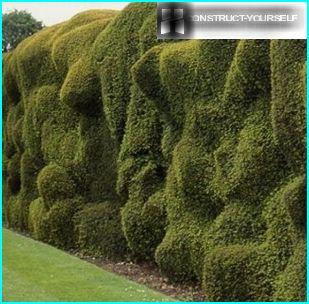
When pruning and trimming the hedges can be shaped in any form, even the most bizarre
Holding a watering and fertilizing
During the season the hedges need to be regularly watered, pre-ratrakov soil 50-70 cm on either side of the landing. When watering the water jet is directed directly to the base of the plants, providing moisture of the soil to a depth of 30-40 cm.
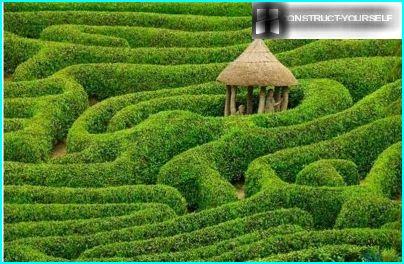
With low rounded form hedges in the garden maze — a place for children’s games and secluded relaxation
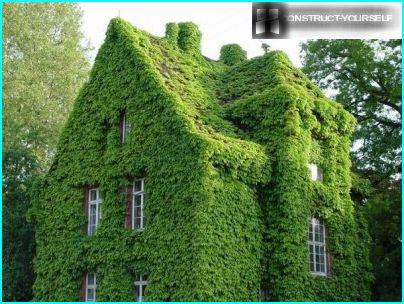
After dropping off the twine plant at the walls of your home and making a simple frame, you will become the owner of a work of landscape art
In addition to watering, hedges need to be fed organic and mineral fertilizers. Organic fertilizer — compost, leaf humus, peat entered in the dug up soil in early spring or fall in an amount of from 2 to 5 kg per square meter of land. Mineral fertilizers — nitrogen and phosphate-potash added to the soil depending on the season: nitrogen only at the beginning of the spring, phosphate — mainly in late summer and early autumn. Autumn bait can consist of these components: 30-40 g of potassium salt, 50-70 g of superphosphate, 50-70 g of ammonium sulfate.






